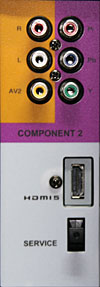Vizio VF550XVT LCD TV Setup & Tests
The VF550XVT offers more preset picture modes than most sets I've seen, including several labeled with the names of various sports, such as football, baseball, basketball, and golf. I guess these presets are designed to "optimize" the picture for these types of programs.
As always, I prefer to set up the TV according to the normal system standards. The Movie mode was closest to correct—black level was right on the money, though the white level was clipped a bit. Color was slightly off, but tint was perfect, as was sharpness. However, increasing the sharpness even one click induced severe ringing (white halos around black lines on a gray background).

The picture controls are tied to the picture modes, not the inputs. If you need to use different settings for different inputs, you must adjust different picture modes and assign them to the appropriate inputs. This is true even for the Custom picture mode. At least there are lots of picture modes, so this is not as much of a problem as it usually is.
There are several color-temperature presets, though there's no Warm preset as with most TVs. The Normal preset is closest to correct, but it tends slightly toward blue. AS mentioned earlier, this TV offers only one set of red, green, and blue calibration controls instead of two, the minimum required to dial in the grayscale. The RGB controls are available for all color-temp presets, not just Custom, so why even have a setting called Custom?
Each control increases or decreases the level of its respective color across the brightness range, but since the color response was not flat across the range, it was impossible to get the grayscale entirely correct. When I started from the Normal preset, the final result was not great, but when I started from the Custom preset—which was very blue at its default settings—I was able to get it closer to correct across the board (see Measurements).
Fortunately, the color gamut was very close to accurate. This is great news, since the VF550XVT has no color-management system with which to adjust the color points.
 As I was taking white- and black-level measurements, it quickly became obvious that this set's Achilles' heel is black level, which was relatively high—not good in my book. As I was to discover during my subsequent testing, it also exhibited better-than-usual off-axis performance, which, along with a high black level, implies the use of IPS (in-plane switching) glass, a hallmark of LG LCDs.
As I was taking white- and black-level measurements, it quickly became obvious that this set's Achilles' heel is black level, which was relatively high—not good in my book. As I was to discover during my subsequent testing, it also exhibited better-than-usual off-axis performance, which, along with a high black level, implies the use of IPS (in-plane switching) glass, a hallmark of LG LCDs.
Personally, I prefer the other trade-off—better blacks and worse off-axis performance. I suppose you can have the best of both worlds with IPS glass and LED local dimming, which is what we might expect from Vizio's upcoming LED LCD.
When I first displayed a full-screen white field, I noticed a 1-pixel-wide, vertical blue line running the entire height of the screen about 10 percent of the screen's width from the left. Not only that, there was one stuck red pixel in the line about a quarter of the screen's height from the top.
A Vizio rep suggested that I unplug the set for 15 minutes to reset the processor, then plug it in and turn it on, which I did. The line was still there, but fainter than before. And a short time later, it disappeared completely, except for the stuck pixel. Over the course of the review, that line continued to appear and disappear, while the stuck pixel remained. I wasn't too worried about this, since the Vizio warranty would replace the entire set if it happened to a consumer.
Moving on to my standard test discs, I started with the HQV Benchmark DVD at 480i via component. Jaggies were mild to moderate, and detail was okay but not great. On the plus side, the set's noise reduction was quite effective without softening the image appreciably. Also, it picked up 3:2 pulldown instantly, though 2:2 video had lots of jaggies. Frame interpolation clearly sharpened the detail in the moving race car and bleacher seats.
Looking at the HQV Benchmark HD DVD at 1080i via HDMI, the Strong noise-reduction setting did soften the picture a bit, so I left it at Medium. Jaggies were invisible. The video resolution-loss test looked solid and stable, but the horizontal bursts were slightly cyan and the vertical bursts were a bit pinkish.
Without frame interpolation, the movement in the film resolution-loss test was very juddery, while turning frame interpolation on smoothed out the motion considerably. However, I didn't see much improvement in the detail of the bleacher seats during the pan, and there was some obvious smudging in the monoscope bursts, though the cyan and pink color casts were gone. Setting Smooth Motion and Real Cinema to different values didn't seem to have much effect on the smudging.
Finally, I played the FPD Benchmark Blu-ray test disc. Sure enough, frame interpolation sharpened the motion clips considerably, at least when Real Cinema was set to Smooth, though the bursts in the scrolling monoscope had the smudging artifacts; the Precision setting didn't seem to do much at all. There were no artifacts to speak of in the other motion tests with Real Cinema set to Smooth, so that's where I left it for most of the review.
- Log in or register to post comments






























































